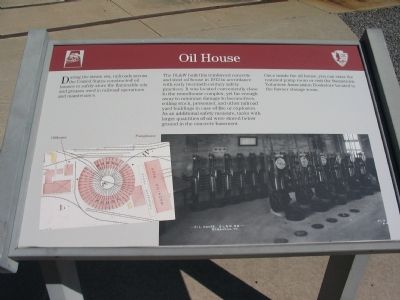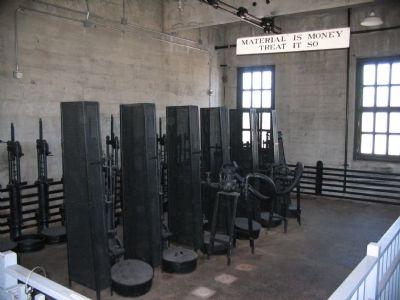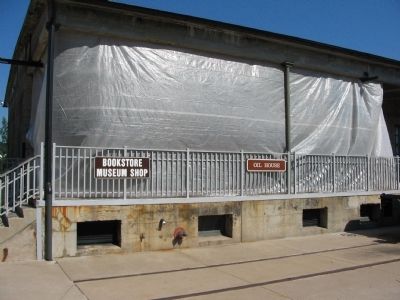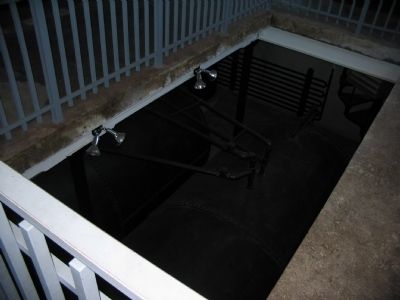Scranton in Lackawanna County, Pennsylvania — The American Northeast (Mid-Atlantic)
Oil House
Inscription.
During the steam era, railroads across the United States constructed oil houses to safely store the flammable oils and greases used in railroad operations and maintenance.
The DL&W built this reinforced concrete and steel oil house in 1912 in accordance with early twentieth-century safety practices. It was located conveniently close to the roundhouse complex, yet far enough away to minimize damage to locomotives, rolling stock, personnel, and other railroad yard buildings in case of fire or explosion. As an additional safety measure, tanks with larger quantities of oil were stored below ground in the concrete basement.
Once inside the oil house, you can enter the restored pump room or visit the Steamtown Volunteer Association Bookstore located in the former storage room.
Erected by Steamtown Nataionl Historic Site - National Park Service.
Topics. This historical marker is listed in this topic list: Railroads & Streetcars. A significant historical year for this entry is 1912.
Location. 41° 24.471′ N, 75° 40.29′ W. Marker is in Scranton, Pennsylvania, in Lackawanna County. Marker can be reached from Mechanic Street, on the left when traveling east. Located between the Oil House and Museum Building in Steamtown National Historic Site. Touch for map. Marker is in this post office area: Scranton PA 18503, United States of America. Touch for directions.
Other nearby markers. At least 8 other markers are within walking distance of this marker. A different marker also named Oil House (here, next to this marker); Tank Car (here, next to this marker); 1902 Roundhouse Office (a few steps from this marker); Oil House Foundation (within shouting distance of this marker); Steamtown (within shouting distance of this marker); CNJ #5 Steam Derrick (within shouting distance of this marker); Illinois Central #790 (within shouting distance of this marker); Claremont & Concord Snow Plow #60 (within shouting distance of this marker). Touch for a list and map of all markers in Scranton.
Also see . . . Steamtown National Historic Site. National Park Service home for the park. (Submitted on June 8, 2009, by Craig Swain of Leesburg, Virginia.)
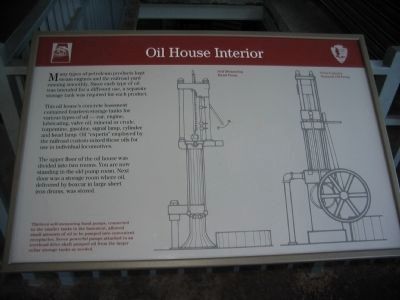
Photographed By Craig Swain, July 25, 2008
5. Oil House Interior
Many types of petroleum products kept steam engines and the railroad yard running smoothly. Since each type of oil was intended for a different use, a separate storage tank was required for each product.
This oil house's concrete basement contained fourteen storage tanks for various types of oil - car, engine, lubricating, valve oil, mineral or crude, turpentine, gasoline, signal lamp, cylinder and head lamp. Oil "experts" employed by the railroad custom-mixed these oils for use in individual locomotives.
The upper floor of the oil house was divided into two rooms. Next door was a storage room where oil delivered by boxcar in large sheet iron drums, was stored.
Thirteen self-measuring hand pumps, connected to the smaller tanks in the basement, allowed small amounts of oil to be pumped into convenient receptacles. Seven powerful pumps attached to an overhead drive shaft pumped oil from the larger cellar storage tanks as needed.
This oil house's concrete basement contained fourteen storage tanks for various types of oil - car, engine, lubricating, valve oil, mineral or crude, turpentine, gasoline, signal lamp, cylinder and head lamp. Oil "experts" employed by the railroad custom-mixed these oils for use in individual locomotives.
The upper floor of the oil house was divided into two rooms. Next door was a storage room where oil delivered by boxcar in large sheet iron drums, was stored.
Thirteen self-measuring hand pumps, connected to the smaller tanks in the basement, allowed small amounts of oil to be pumped into convenient receptacles. Seven powerful pumps attached to an overhead drive shaft pumped oil from the larger cellar storage tanks as needed.
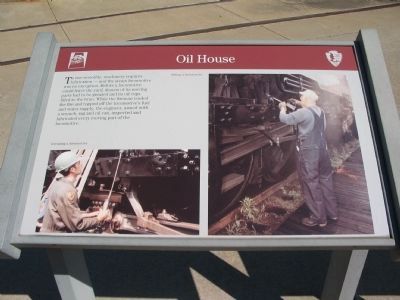
Photographed By Craig Swain, July 25, 2008
6. Oil House
Standing next to the marker is this interpretive display:
To run smoothly, machinery requires lubrication - and the steam locomotive was no exception. Before a locomotive could leave the yard, dozens of its moving parts had to be greased and its oil cups filled to the brim. While the fireman tended the fire and topped off the locomotive's fuel and water supply, the engineer, armed with the wrench, rag and oil can, inspected and lubricated every moving part of the locomotive.
To run smoothly, machinery requires lubrication - and the steam locomotive was no exception. Before a locomotive could leave the yard, dozens of its moving parts had to be greased and its oil cups filled to the brim. While the fireman tended the fire and topped off the locomotive's fuel and water supply, the engineer, armed with the wrench, rag and oil can, inspected and lubricated every moving part of the locomotive.
Credits. This page was last revised on June 16, 2016. It was originally submitted on June 8, 2009, by Craig Swain of Leesburg, Virginia. This page has been viewed 941 times since then and 21 times this year. Photos: 1, 2, 3, 4, 5, 6. submitted on June 8, 2009, by Craig Swain of Leesburg, Virginia.
